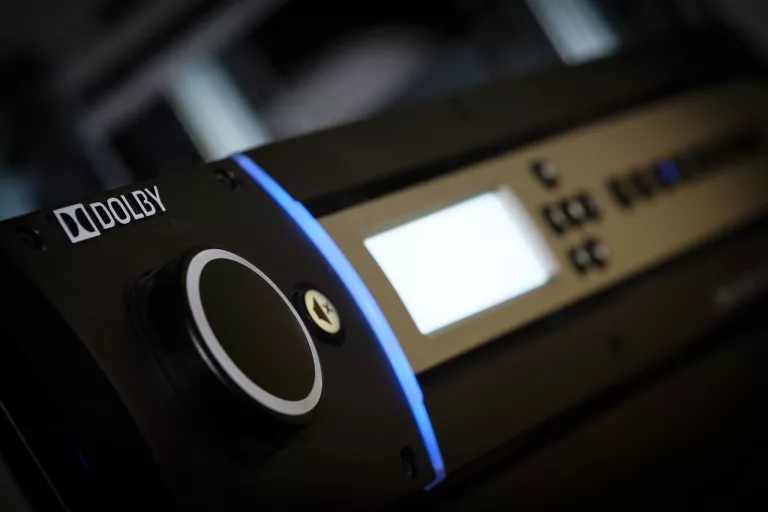Dolby Atmos


In the complex world of advanced audio configurations, precise understanding of the role of each speaker becomes essential.
Whether we explore a classic stereo configuration, a 5.1 immersion, a 7.1 experience, or the three-dimensional world of Dolby Atmos, each speaker contributes in a specific way to creating a unique listening experience.
Stereo: The Art of Left and Right Channels
In a traditional stereo setup, two speakers are used: one for the left channel and one for the right channel.
These speakers work together to construct a two-dimensional soundstage, where the left channel delivers sound elements intended for the left ear, and the right channel handles those intended for the right ear.
This separation provides clarity in the reproduction of instruments, therefore creating an illusion of space.
5.1 Surround Sound: Immersion in the Heart of the Action
The 5.1 format adds an extra dimension to the audio experience by incorporating five main speakers and a subwoofer (.1).
The speakers are distributed as follows:
- Three front speakers (left, center, right) handle dialogue and main sounds.
- Two rear speakers create sound immersion by reproducing environmental effects or ambient noise.
- The subwoofer adds power and depth with bass frequency management.
Evolution towards 7.1: An Additional Dimension
The 7.1 configuration extends the sound space even further with the addition of two rear speakers.
The distribution is therefore as follows:
- Three front speakers (left, center, right) retain their role for the main sound elements.
- Four rear speakers (left, right, left surround, right surround) create an even more immersive sound envelope.
- The subwoofer remains crucial for managing bass frequencies.
Dolby Atmos: A Vertical Revolution
Dolby Atmos completely reinvents the audio experience by introducing a vertical dimension.
In addition to traditional speakers, additional height speakers allow precise sound localization above the listener.
The configuration can therefore include:
- Floor speakers for traditional channels (left, center, right, left surround, right surround).
- Ceiling speakers or reflective speakers for audio effects located above.
- Subwoofer for bass frequency management.


Impact on the Hearing Experience:
- Stereo: Creates a two-dimensional sound image, ideal for music and classical audio recordings.
- 5.1: Provides sound immersion, particularly effective in films and video games, where surround effects are essential.
- 7.1: Expands the sound space even further, adding an extra layer of immersion for a more immersive experience.
- Dolby Atmos: Revolutionizes the experience by introducing audio elements located above the listener, providing three-dimensional sound spatialization.
By demystifying the role of each speaker in these advanced configurations, audio enthusiasts can better appreciate the complexity and richness of the modern audio experience.
Whether in the comfort of a cinema room equipped with Dolby Atmos, or in the living room with a 7.1 configuration, each speaker contributes to weaving an immersive and captivating sound web.
Advanced Configurations for Audiophiles: Hi-Fi and 3D Audio
Audiophiles, looking for exceptional audio quality, are turning to more advanced configurations.
On the other hand, 3D audio goes even further by introducing advanced sound spatialization techniques, thus offering unparalleled three-dimensional immersion.
The Emergence of Audio 9.1.6: An Ultra-Immersive Experience
The race for audio immersion continues with the emergence of configurations such as 9.1.6 audio.
This bold setup combines nine main speakers, a subwoofer, a traditional 7.1 configuration, and six additional speakers for the ultimate audio experience.
These six additional speakers create an even more pronounced vertical dimension, therefore enveloping the listener in a cocoon of sound.
New Frontiers in Personalized Listening: Binaural Audio and Sound Profiling
Technological advances also enable the emergence of binaural audio, a technique that uses two microphones to create a three-dimensional listening experience, simulating the positioning of human ears.
Additionally, personalized sound profiling is growing in popularity, where users can adjust audio settings based on their individual preferences, providing a truly tailored listening experience.
These developments demonstrate continued innovation in audio, providing music lovers and sound enthusiasts with ever more sophisticated options for a tailored listening experience.
Whether you’re looking for total immersion with 9.1.6 audio or prefer the precision of binaural audio, choices abound to satisfy the most demanding audiophiles.
Dolby Atmos: Revolutionizing the Music Industry thanks to Advanced Audio Formats
The increasing adoption of advanced audio setups has had a significant impact on the music industry.
Artists and producers are adapting to create recordings that take full advantage of these configurations, seeking to provide an immersive listening experience.
Labels are increasingly integrating these formats into their catalogs, thus capitalizing on the growing demand from audiophiles.


Dolby Atmos: Technical and Creative Challenges for Sound Professionals
While these configurations provide an exceptional listening experience, they also present technical and creative challenges.
Audio professionals need to rethink how they record, mix and master music to take advantage of these setups.
Increased precision therefore requires particular attention to detail, while sound spatialization requires a more immersive and artistic approach.
Accessibility and Growing Adoption in the General Public
As technology evolves, these advanced configurations become more and more accessible to the general public.
From affordable 3D audio systems to Dolby Atmos setups for home theaters, consumers now have the opportunity to enjoy an exceptional sound experience in the comfort of their own home.
This democratization therefore promises to redefine the standard of audio listening, opening new perspectives for the entertainment industry.
Dolby Atmos: The Emergence of New Professions in the Audio Field
The expansion of audio setups has created new professional opportunities.
From specialists in sound spatialization to Dolby Atmos engineers, new professions are emerging to meet the needs of this technological evolution.
These professionals therefore play an essential role in creating unique sound experiences, thus contributing to the constant evolution of the audio industry.
Impact on Musical Creation and Live Performances
Artists are increasingly integrating these advanced configurations into their creative process.
Musical composition evolves to fully exploit the possibilities offered by configurations like Dolby Atmos. Additionally, live performances integrate these technologies, providing audiences with an immersive experience that transcends the traditional boundaries of live music.
These changes influence musical creativity and thus redefine the standards of the entertainment industry.


Conclusion
The evolution of audio formats, from stereo to Dolby Atmos, has redefined the way we listen to music.
These advances therefore offer new dimensions to the auditory experience, opening doors to artistic creativity and total immersion.
As the music industry adapts to these changes, one thing is certain: the future of audio listening still holds many surprises.
Whether in a concert hall, a recording studio or an audiophile’s living room, the quest for the best sound experience continues to evolve.
